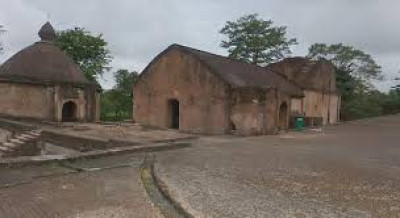In Depth
Originally constructed as a strategic military base, the Talatal Ghar was designed not only as a royal residence but also as a defense fortress. The structure was made using indigenous materials like bricks and a natural cementing compound created from bora chaul (sticky rice), duck eggs, and other organic ingredients — a unique Assamese building technique that has withstood centuries of weathering.
Historical Background
The Talatal Ghar was first conceptualized by King Rudra Singha, who shifted his capital from Garhgaon to Rangpur (modern-day Sivasagar) around 1707. He appointed Ghanashyam, an architect from Cooch Behar, to design the new capital city and palace. However, it was during King Rajeswar Singha’s reign (1751–1769) that the palace took its current form — a robust seven-story structure that served both as a royal court and military headquarters.
Architectural Brilliance
The design of the Talatal Ghar reflects the ingenuity of the Ahoms. The lower three levels — the actual Talatal — were used for storage, secret meetings, and escape routes. Two secret tunnels were built for emergencies: one led to the Dikhow River (around 3 km away), and the other stretched nearly 16 km to the Garhgaon Palace, enabling safe escape during enemy attacks.
The ground floors contained stables, storerooms, and servants' quarters, while the upper floors housed royal apartments, assembly halls, prayer rooms, and council chambers. The octagonal Puja Ghar (prayer house), Mantranaghar (conference room), and Barcharā (assembly hall) were integral parts of the upper structure. The palace once had intricate carvings of floral patterns, divine figures, and hunting scenes that adorned its walls.
Strategic and Cultural Importance
Talatal Ghar served as both a symbol of Ahom power and a functional military hub. Its hidden passages and thick fortifications reflect the political tension of its time — especially during the Moamoria rebellion and Burmese invasions. It was part of a fortified complex surrounded by a moat and brick wall, with the nearby Gola Ghar used as an armory for storing gunpowder and ammunition.
Despite partial destruction during British rule, the remains of the Talatal Ghar continue to narrate tales of Ahom valor, artistry, and statecraft. Archaeological excavations and preservation efforts by the Archaeological Survey of India (ASI) have helped protect this heritage site, making it one of the most visited historical monuments in Assam.
Visiting Talatal Ghar Today
Located about 3 kilometers from the heart of Sivasagar town, Talatal Ghar is easily accessible by road and is part of the Rangpur archaeological complex, which also includes the Rang Ghar, Kareng Ghar, and Gola Ghar. Visitors can explore the palace corridors, the remains of ancient chambers, and the scenic surroundings that once witnessed the grandeur of the Ahom Empire.
Key Facts at a Glance
-
Built by: Swargadeo Rajeswar Singha
-
Construction period: Around 1765 A.D.
-
Total floors: 7 (4 above, 3 underground)
-
Architect: Ghanashyam from Cooch Behar
-
Main materials: Brick and natural cement from rice & egg mixture
-
Location: Rangpur, Sivasagar, Assam
-
Famous for: Secret tunnels, underground floors, royal architecture
-
Distance: 3 km from Sivasagar town center
Today, the Talatal Ghar is not only a must-visit historical monument but also a crucial chapter in understanding the Ahom Kingdom’s military strategy and cultural excellence. It remains one of the top tourist attractions in Sivasagar, drawing history enthusiasts, archaeologists, and travelers alike.
To book an advanced ticket for the Historical Talatal Ghar, please use the official Archaeological Survey of India (ASI) e-ticket portal or the on-site QR code system.
Talatal Ghar Quick Info Table
| Attribute | Details |
|---|---|
| Monument Name | Talatal Ghar |
| Location | Rangpur, Sivasagar, Assam, India |
| Built By | Swargadeo Rajeswar Singha |
| Year of Construction | Circa 1765 A.D. |
| Total Floors | 7 (4 above, 3 underground) |
| Architectural Style | Ahom architecture |
| Materials Used | Bricks, Bora Chaul, Duck Eggs |
| Famous For | Secret tunnels and underground floors |
| Managed By | Archaeological Survey of India (ASI) |
| Distance from Sivasagar | About 3 kilometers |
FAQs on Talatal Ghar
-
What is Talatal Ghar famous for?Talatal Ghar is known for its seven-storeyed structure and secret underground tunnels built by the Ahom kings in Sivasagar, Assam.
-
Who built Talatal Ghar in Assam?It was built by Swargadeo Rajeswar Singha, an Ahom king, in 1765 A.D.
-
Where is Talatal Ghar located?Talatal Ghar is located in Rangpur, about 3 km from Sivasagar town in Assam, India.
-
How many floors does Talatal Ghar have?It has seven floors — four above the ground and three underground.
-
Why was Talatal Ghar built?It served as a royal palace and a strategic military base for the Ahom rulers.
-
What materials were used to build Talatal Ghar?The structure was built using bricks and a natural cement mixture made from sticky rice and duck eggs.
-
Are the underground tunnels open to visitors?No, the tunnels are sealed for safety reasons by the Archaeological Survey of India.
-
Which king started building Talatal Ghar?The initial structure was started by King Rudra Singha and expanded by Rajeswar Singha.
-
What is the distance between Sivasagar town and Talatal Ghar?It is located approximately 3 kilometers from the center of Sivasagar town.
-
What are the nearby tourist attractions of Talatal Ghar?Nearby attractions include Rang Ghar, Kareng Ghar, Joysagar Tank, and Sivasagar Tank & Temple.
